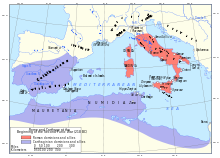
Back Zweiter Punischer Krieg ALS Ōðre Penisc Gūþ ANG الحرب البونيقية الثانية Arabic ایکینجی کارتاژ ساواشی AZB Yuda Punic Kakalih BAN Другая Пунічная вайна Byelorussian Втора пуническа война Bulgarian Eil brezel punek Breton Drugi punski rat BS Segona Guerra Púnica Catalan
| Second Punic War | |||||||||
|---|---|---|---|---|---|---|---|---|---|
| Part of the Punic Wars | |||||||||
 The western Mediterranean in 218 BC | |||||||||
| |||||||||
| Belligerents | |||||||||
|
Carthage
| ||||||||
| Commanders and leaders | |||||||||
| |||||||||
The Second Punic War (218 to 201 BC) was the second of three wars fought between Carthage and Rome, the two main powers of the western Mediterranean in the 3rd century BC. For 17 years the two states struggled for supremacy, primarily in Italy and Iberia, but also on the islands of Sicily and Sardinia and, towards the end of the war, in North Africa. After immense materiel and human losses on both sides, the Carthaginians were once again defeated. Macedonia, Syracuse and several Numidian kingdoms were drawn into the fighting, and Iberian and Gallic forces fought on both sides. There were three main military theatres during the war: Italy, where Hannibal defeated the Roman legions repeatedly, with occasional subsidiary campaigns in Sicily, Sardinia and Greece; Iberia, where Hasdrubal, a younger brother of Hannibal, defended the Carthaginian colonial cities with mixed success before moving into Italy; and Africa, where Rome finally won the war.
The First Punic War had ended in a Roman victory in 241 BC after 23 years and enormous losses on both sides. After the war Carthage expanded its holdings in Iberia where in 219 BC a Carthaginian army under Hannibal besieged, captured and sacked the pro-Roman city of Saguntum. In spring 218 BC Rome declared war on Carthage, beginning the Second Punic War. Later that year, Hannibal surprised the Romans by marching his army overland from Iberia, through Gaul and over the Alps to Cisalpine Gaul (modern northern Italy). Reinforced by Gallic allies he obtained crushing victories over the Romans at the battles of Trebia (218) and Lake Trasimene (217). Moving to southern Italy in 216 Hannibal defeated the Romans again at the battle of Cannae, where he annihilated the largest army the Romans had ever assembled. After the death or capture of more than 120,000 Roman troops in less than three years, many of Rome's Italian allies, notably Capua, defected to Carthage, giving Hannibal control over much of southern Italy. As Syracuse and Macedonia joined the Carthaginian side after Cannae, the conflict spread. Between 215 and 210 BC the Carthaginians attempted to capture Roman-held Sicily and Sardinia, but were unsuccessful. The Romans took drastic steps to raise new legions: enrolling slaves, criminals and those who did not meet the usual property qualification; this vastly increased the number of men they had under arms. For the next decade the war in southern Italy continued, with Roman armies slowly recapturing most of the Italian cities that had joined Carthage.
The Romans established a lodgement in north-east Iberia in 218 BC; the Carthaginians repeatedly attempted and failed to reduce it. In 211 the Romans took the offensive in Iberia and were badly defeated but maintained their hold on the north-east. In 209 BC the new Roman commander Publius Scipio captured Carthago Nova, the main Carthaginian base in the peninsula. In 208 Scipio defeated Hasdrubal, although Hasdrubal was able to withdraw most of his troops into Gaul and then Cisalpine Gaul in early 207 BC. This new Carthaginian invasion was defeated at the Battle of the Metaurus. At the battle of Ilipa in 206 Scipio permanently ended the Carthaginian presence in Iberia.
Scipio invaded Carthaginian Africa in 204 BC, compelling the Carthaginian Senate to recall Hannibal's army from Italy. The final engagement of the war took place between armies under Scipio and Hannibal at Zama in 202 and resulted in Hannibal's defeat and in Carthage suing for peace. The peace treaty dictated by Rome stripped Carthage of all of its overseas territories and some of its African ones. An indemnity of 10,000 silver talents was to be paid over 50 years. Carthage was prohibited from waging war outside Africa, and in Africa only with Rome's express permission. Henceforth it was clear Carthage was politically subordinate to Rome. Rome used Carthaginian military activity against the Numidians as a pretext to declare war again in 149 BC starting the Third Punic War. In 146 BC the Romans stormed the city of Carthage, sacked it, slaughtered most of its population and completely demolished it.